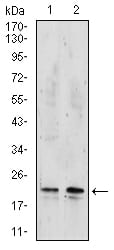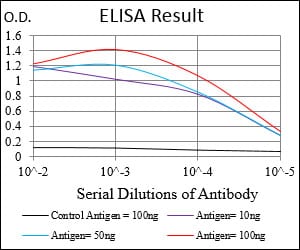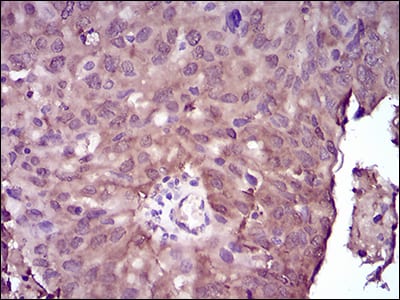


| WB | 1/500-1/1000 | Human,Mouse,Rat |
| IF | 1/20 | Human,Mouse,Rat |
| IHC | 1/50-1/100 | Human,Mouse,Rat |
| ICC | 技术咨询 | Human,Mouse,Rat |
| FCM | 咨询技术 | Human,Mouse,Rat |
| Elisa | 咨询技术 | Human,Mouse,Rat |
| Aliases | PUF; NDKB; NDPKB; NM23B; NDPK-B; NM23-H2 |
| Entrez GeneID | 4831 |
| clone | 4G7A8 |
| WB Predicted band size | 17.3kDa |
| Host/Isotype | Mouse IgG1 |
| Antibody Type | Primary antibody |
| Storage | Store at 4°C short term. Aliquot and store at -20°C long term. Avoid freeze/thaw cycles. |
| Species Reactivity | Human |
| Immunogen | Purified recombinant fragment of human NME2 (AA: FULL(1-152)) expressed in E. Coli. |
| Formulation | Purified antibody in PBS with 0.05% sodium azide. |
+ +
以下是关于HIF Prolyl Hydroxylases(PHDs)抗体的3篇参考文献示例,基于经典研究整理:
1. **Title**: "C. elegans EGL-9 and mammalian homologs define a family of dioxygenases that regulate HIF by prolyl hydroxylation"
**Authors**: Epstein, A.C., Gleadle, J.M., McNeill, L.A., et al.
**摘要**: 该研究首次鉴定了哺乳动物中PHD酶(如PHD1-3)的同源物,并通过特异性抗体验证了这些酶在低氧条件下对HIF-1α的羟基化调控作用,为后续抗体在缺氧信号研究中的应用奠定基础。
2. **Title**: "HIFα targeted for VHL-mediated destruction by proline hydroxylation: implications for O2 sensing"
**Authors**: Ivan, M., Kondo, K., Yang, H., et al.
**摘要**: 本文利用针对羟基化HIF-α的抗体,证明PHD酶通过催化HIF-α的脯氨酸羟基化促进其降解,揭示了氧感知机制,相关抗体被广泛应用于检测HIF的翻译后修饰状态。
3. **Title**: "Differential roles of hypoxia-inducible factor 1α (HIF-1α) and HIF-2α in hypoxic gene regulation"
**Authors**: Hu, C.J., Wang, L.Y., Chodosh, L.A., et al.
**摘要**: 研究通过PHD2特异性抗体,分析了不同缺氧条件下PHD2蛋白的表达变化及其对HIF-1α/HIF-2α的差异调控,强调了抗体在区分HIF亚型功能中的关键作用。
4. **Title**: "Prolyl hydroxylase domain inhibitors: a route to HIF activation and neuroprotection"
**Authors**: Siddiq, A., Aminova, L.R., Ratan, R.R.
**摘要**: 该文献描述了PHD抑制剂的神经保护机制,并利用抗体验证PHD酶活性抑制后HIF-1α的稳定性,展示了抗体在药物开发与功能研究中的双重价值。
---
**注**:以上文献为领域内经典研究示例,实际引用时请核对最新文献及具体抗体应用描述。
HIF prolyl hydroxylases (HPHs), also known as prolyl hydroxylase domain-containing enzymes (PHDs), are oxygen-sensitive enzymes that regulate the stability of hypoxia-inducible factors (HIFs) under normoxic conditions. By catalyzing the hydroxylation of specific proline residues on HIF-α subunits, HPHs mark these proteins for ubiquitination and proteasomal degradation via the von Hippel-Lindau (VHL) E3 ligase complex. This oxygen-dependent process is central to cellular adaptation to hypoxia; under low oxygen, HPH activity is inhibited, allowing HIF-α to accumulate, dimerize with HIF-β, and activate genes involved in angiogenesis, erythropoiesis, and metabolism.
Antibodies targeting HPHs (PHD1/PHD2/PHD3) are critical tools for studying their expression, localization, and regulatory roles in hypoxia signaling. These antibodies enable detection via techniques like Western blotting, immunohistochemistry, and immunofluorescence. Specificity is crucial due to structural similarities among HPH isoforms and their tissue-specific functions. For example, PHD2 is the primary oxygen sensor in most tissues, while PHD3 is upregulated in hypoxia.
Research applications include investigating HPH dysregulation in diseases like cancer (tumor hypoxia), ischemic disorders, and anemia. Therapeutic targeting of HPHs (e.g., PHD inhibitors for anemia treatment) further underscores their biomedical relevance. Validated antibodies with isoform selectivity are essential for mechanistic studies and drug development.
×